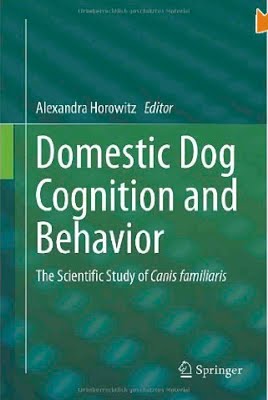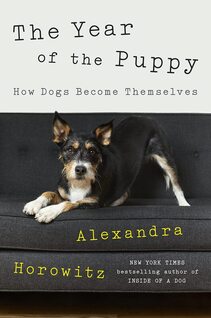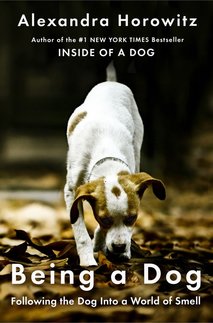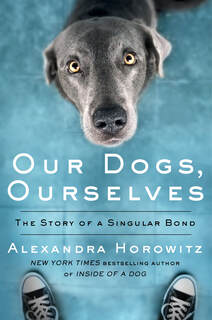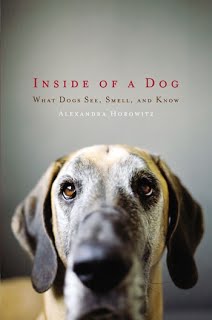Dog Cognition Lab Publications
2023. (Chan, Arellano, & Horowitz) Here puppy, chew on this: Short-term provision of toys does not improve welfare in companion dogs. Animals, 13(21), 3340.
2021. (Leifer, Baum, Cheng, Smith, & Horowitz) (poster) Memory for learned tricks: Do dogs (Canis familiaris) remember a learned behavior better after an overnight sleep? Association of Professional Dog Trainers, virtual conference. Leifer, presenter.
2021. (Bagwell, Leifer, Arellano, Smith, & Horowitz) (poster) The speed of senses: A citizen science study into dogs' alacrity to pursue an olfactory and an auditory cue. Animal Behavior Society, virtual conference. Bagwell, presenter
2021. (Horowitz, West, Ball, & Bagwell) Can dogs limbo? Dogs’ perception of affordances for negotiating an opening. Animals, 11, 620.
2019. (Horowitz & Franks) What smells? Gauging attention to olfaction in canine cognition research. Animal Cognition, 23(1), 11-18.
2019. (Duranton & Horowitz) Let me sniff! Nosework induces positive judgment bias in pet dogs. Applied Animal Behaviour Science, 211, 61-66.
- In sum: While research has found that toys may improve the welfare of kenneled dog populations (shelter- and laboratory-housed dogs), our findings did not find the same to hold with pet dog populations
2021. (Leifer, Baum, Cheng, Smith, & Horowitz) (poster) Memory for learned tricks: Do dogs (Canis familiaris) remember a learned behavior better after an overnight sleep? Association of Professional Dog Trainers, virtual conference. Leifer, presenter.
- In sum: In a citizen-science study, we compared dogs' speed and accuracy in performing a newly-learned behavior ("touch") after a period of sleep at night or during the day; the group that slept after learning the behavior were faster and more accurate in retention
2021. (Bagwell, Leifer, Arellano, Smith, & Horowitz) (poster) The speed of senses: A citizen science study into dogs' alacrity to pursue an olfactory and an auditory cue. Animal Behavior Society, virtual conference. Bagwell, presenter
- In sum: In a citizen-science study, we found that dogs were faster to approach an auditory cue to the location of food than an olfactory cue, but that they could use both effectively
2021. (Horowitz, West, Ball, & Bagwell) Can dogs limbo? Dogs’ perception of affordances for negotiating an opening. Animals, 11, 620.
- In sum: By giving dogs increasingly smaller openings to pass through, we found that dogs show more hesitation approaching openings that are too small than ones through which they comfortably fit. Dogs of all sizes also change their behavior in a uniform way to negotiate short openings
- In sum: We investigated whether owned dogs spontaneously (without training) distinguished their owner's odor from a stranger's odor. Using natural body odor captured on a t-shirt, we found that dogs habituated to a familiar odor and dishabituated to an unfamiliar odor. This finding begins to answer the question of how dogs recognize and represent humans, including their owners
2019. (Horowitz & Franks) What smells? Gauging attention to olfaction in canine cognition research. Animal Cognition, 23(1), 11-18.
- In sum: This paper reviews ten years of dog-cognition research to determine how much the science accounts for odor cues in the testing environment. Finding not much attention to odor, we propose a simple rubric (dubbed SMELL) for reporting olfactory information.
2019. (Duranton & Horowitz) Let me sniff! Nosework induces positive judgment bias in pet dogs. Applied Animal Behaviour Science, 211, 61-66.
- In sum: Dogs who participated in two weeks of nosework games, but not dogs who had participated in heelwork, decreased their latencies to approach an ambiguous stimulus in the cognitive bias test -- often taken as a sign of optimism in animals.
2017. (Horowitz) Smelling themselves: Dogs investigate their own odours longer when modified in an “olfactory mirror” test. Behavioural Processes, 173, 17-24.
- In sum: This study translates the "mirror mark" test of self-awareness for a species whose primary sensory modality is olfaction, and finds that dogs show more investigative interest in their own odours when modified.
2016. (Horowitz & Hecht) Examining dog-human play: The characteristics, affect, and vocalizations of a unique interspecific interaction. Animal Cognition, 19, 779-788.
- In sum: Via a global citizen science project, we solicited videotapes of dog–human play sessions from dog owners. We coded 187 play bouts via frame-by-frame video playback. Amount of physical contact (“touch”), level of activity of owner (“movement”), and physical closeness of dog–owner dyad (“proximity”) were highly correlated with positive affect. Owner vocalizations were found to contain different elements in positive- and neutral-affect play. One novel category of play, “tease”, was found.
2015. (Hecht & Horowitz) Looking at dogs: Human preference for dog physical attributes. Anthrozoös, 28, 153-163.
- In sum: This study investigated peoples’ preferences for dog physical attributes in images of real-life dogs. Subjects showed a preference for some features associated with the infant schema—large eyes and wider-set eyes—and also for human-like attributes of colored irises and a distinct upturn of the commissure, seeming to capture a smile.
2013. (Horowitz, Hecht, & Dedrick) Smelling more or less: Investigating the olfactory experience of the domestic dog. Learning & Motivation, 44, 207-217.
- In sum: Companion dogs do not reliably discriminate quantities when the food can be smelled but not seen. However, subjects gave more attention to the plate containing the larger quantity. Also, owner interest in a plate holding a lesser quantity of food reliably leads dogs to approach that plate.
2012. (Horowitz) Fair is fine, but more is better: Limits to inequity aversion in the domestic dog. Social Justice Research, 25, 195-212.
- In sum: Dogs showed a greater sensitivity to the quantity of a reward than to the fairness of a reward. Subjects selected a trainer who had treated them "unfairly," yet who presented a potentially greater opportunity for future rewards.
2011. (Horowitz) Theory of mind in dogs? Examining method and concept. Learning & Behavior, 39, 314-317.
- In sum: Even the best-designed theory-of-mind tests have intractable logical problems. I call for the introduction of an intermediate stage of ability, a rudimentary theory of mind, to describe performance.
2009. (Horowitz) Disambiguating the "guilty look": Salient prompts to a familiar dog behavior. Behavioural Processes, 81, 447-452.
- In sum: The behaviors of fourteen domestic dogs (Canis familiaris) were videotaped over a series of trials and analyzed for elements that correspond to an owner-identified "guilty look." Trials varied the opportunity for dogs to disobey an owner's command not to eat a desirable treat while the owner was out of the room, and varied the owners' knowledge of what their dogs did in their absence. The results revealed no difference in behaviors associated with the guilty look. By contrast, more such behaviors were seen in trials when owners scolded their dogs. The effect of scolding was more pronounced when the dogs were obedient, not disobedient. These results indicate that a better description of the so-called guilty look is that it is a response to owner cues, rather than that it shows an appreciation of a misdeed.
2009. (Horowitz) Attention to attention in domestic dogs' (Canis familiaris) dyadic play. Animal Cognition, 12, 107-118.
- In sum: This paper reports on research of domestic dog dyadic rough-and-tumble play. The sequential behaviors and head-direction of both dogs were noted throughout the bouts. Play signals were sent nearly exclusively to forward-facing conspecifics; attention-getting behaviors were used most often when a playmate was facing away, and before signaling an interest to play. These dogs showed attention to, and acted to manipulate, a feature of other dogs that mediates their ability to respond: which feature in human interaction is called "attention".
(2007. (Horowitz & Bekoff) Naturalizing anthropomorphism: Behavioral prompts to our humanizing of animals. Anthrozoös, 20, 23-35.
Collaborative publications:
2023. (Kerns, Dumen, Kochendorfer, Gastelle, Obeldobel, Horowitz) Are children’s relationships with pet dogs uniquely related to children’s social and emotional competence and adjustment? Human-Animal Interactions 11:1.
2023. (Volsche, Gunnip, Brown, Kiperash, Root-Gutteridge, Horowitz) Dogs produce distinctive play pants: Confirming Simonet et al. (2001). International Journal of Comparative Psychology, 35.
2022. (Volsche, Root-Gutteridge, Korzeniowska, Horowitz) Centring individual animals to improve research and citation practices. Biological Reviews. https://doi.org/10.1111/brv.12912
2022. (Andrews, Pascalau, Horowitz, Lawrence, Johnson) Extensive connections of the canine olfactory pathway revealed by tractography and dissection. Journal of Neuroscience, 42(33), 6392-6407.
2022. (Kerns, Dulmen, Kochendorfer, Obeldobel, Gastelle, Horowitz) Assessing children’s relationships with pet dogs: A multi-method approach. Social Development. doi:10.1111/sode.12622
2020. (Sykes, Beirne, Horowitz, et al.) Humanity’s best friend: A dog-centric approach to addressing global challenges. Animals, 10, 502.
2018. (Franks, Sebo, Horowitz) Fish are smart and feel pain. What about joy? Animal Sentience, 21(16).
2018. (Horowitz, Franks, Sebo) Fill-in-the-blank-emotion in dogs? Evidence from brain imaging. Animal Sentience, 22(20).
- In sum: We bring together previously disparate accounts of why and how we anthropomorphize and suggest a means to analyze anthropomorphizing behavior itself, via analysis of bouts of dyadic play between humans and a heavily anthropomorphized animal, the domestic dog. Four distinct patterns of social interaction recur in successful dog-human play: directed responses by one player to the other, indications of intent, mutual behaviors, and contingent activity. These findings serve as a preliminary answer to the question, "What behaviors prompt anthropomorphisms?"
Collaborative publications:
2023. (Kerns, Dumen, Kochendorfer, Gastelle, Obeldobel, Horowitz) Are children’s relationships with pet dogs uniquely related to children’s social and emotional competence and adjustment? Human-Animal Interactions 11:1.
2023. (Volsche, Gunnip, Brown, Kiperash, Root-Gutteridge, Horowitz) Dogs produce distinctive play pants: Confirming Simonet et al. (2001). International Journal of Comparative Psychology, 35.
2022. (Volsche, Root-Gutteridge, Korzeniowska, Horowitz) Centring individual animals to improve research and citation practices. Biological Reviews. https://doi.org/10.1111/brv.12912
2022. (Andrews, Pascalau, Horowitz, Lawrence, Johnson) Extensive connections of the canine olfactory pathway revealed by tractography and dissection. Journal of Neuroscience, 42(33), 6392-6407.
2022. (Kerns, Dulmen, Kochendorfer, Obeldobel, Gastelle, Horowitz) Assessing children’s relationships with pet dogs: A multi-method approach. Social Development. doi:10.1111/sode.12622
2020. (Sykes, Beirne, Horowitz, et al.) Humanity’s best friend: A dog-centric approach to addressing global challenges. Animals, 10, 502.
2018. (Franks, Sebo, Horowitz) Fish are smart and feel pain. What about joy? Animal Sentience, 21(16).
2018. (Horowitz, Franks, Sebo) Fill-in-the-blank-emotion in dogs? Evidence from brain imaging. Animal Sentience, 22(20).
Domestic Dog Cognition and Behavior
|
The first edited academic volume on the study of dog behavior and cognition. Eleven chapters from leading researchers describe innovative methods from comparative psychology, ethology, and behavioral biology. (Click through for pdfs of Horowitz Preface and ToC; and Horowitz & Hecht, "Looking at dogs: From anthropomorphism to canid umwelt", under "Publications")
|
Books by Alexandra Horowitz
|
The Year of the Puppy: How Dogs Become Themselves (2022)
Being a Dog: Following a Dog into the World of Smell (2016)
|
Our Dogs, Ourselves: The Story of a Singular Bond (2019)
Inside of a Dog: What Dogs See, Smell, and Know (2009)
|
